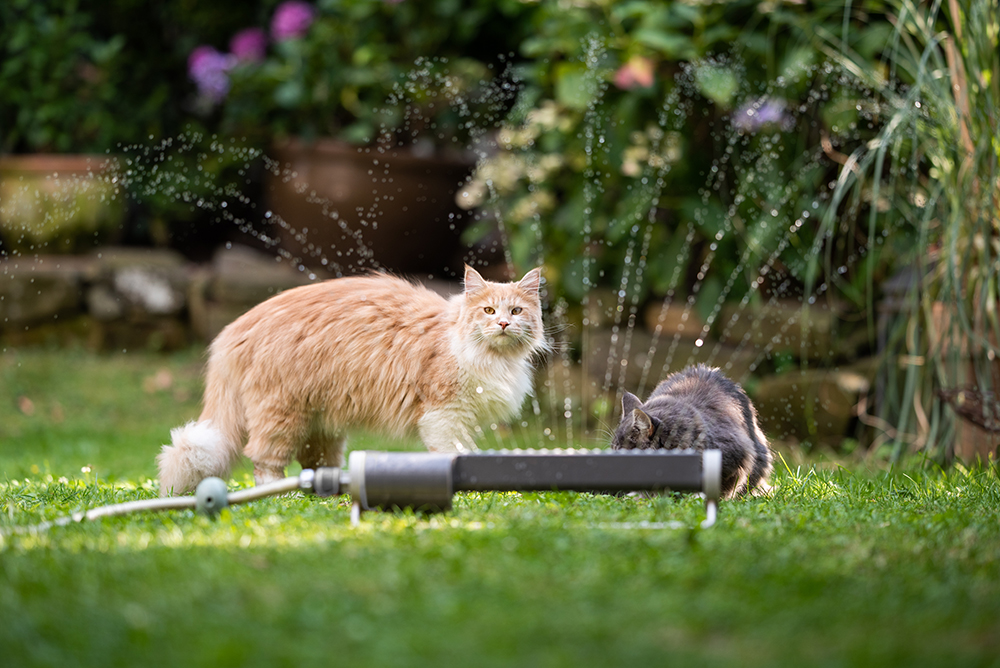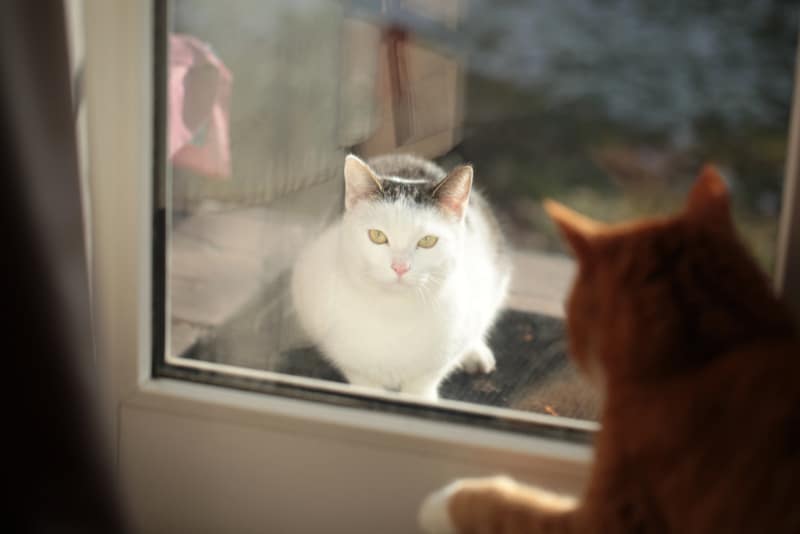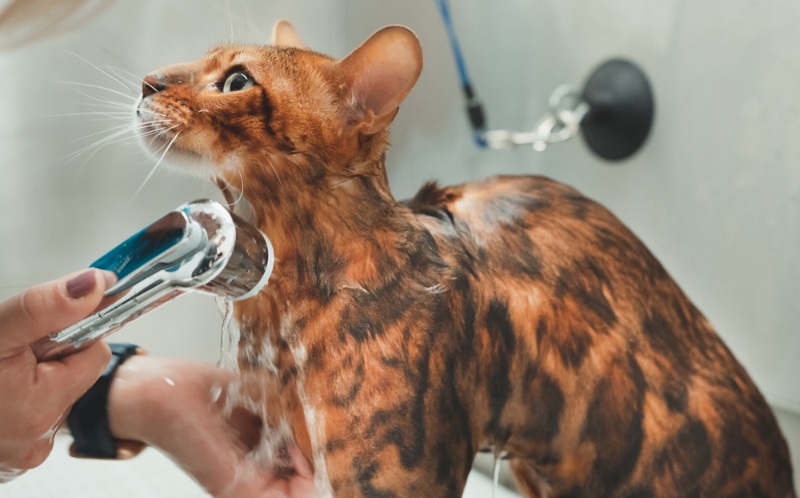Feral, strays, and outdoor felines are generally harmless for the most part. They tend to stay away from strangers and try to go unnoticed throughout their daily escapades. However, they can be troublesome when it comes to maintaining things like gardens and garbage on your property. If you’re annoyed by the neighborhood cats, there are a few things that you can do to help keep them away from your property.

The 8 Tips on How to Keep Neighborhood Cats Away
1. Utilize Citrus Peels
Citrus scents repel cats, so you can use these to help keep unwanted cats off of your property in general. You can do this by simply sprinkling orange and lemon peels around your yard, especially near the perimeters. The citrus peels will help make cats disinterested in even exploring your property because they won’t want to deal with the citrus scent up close and personal.

2. Make the Trek Uncomfortable
An effective way to keep unwanted cats out of your yard is to make the trek uncomfortable for them. By scattering pinecones in the areas where cats tend to be the most burdensome or simply around the perimeter of your property, the cats are likely to find the space hostile and won’t want any part of it. Another option is to use chicken wire, sharp-edged mulch, or plastic forks as uncomfortable footing.
3. Invest in Cat Repellent
Various cat repellents on the market can be used outdoors to keep unwanted felines away from your property. These products contain scents that cats find unpleasant, so they don’t want to go near the source of the smell. You’ll likely have to spray the repellent around the perimeter of your yard a few times a week to ensure ongoing effectiveness.
4. Install Motion Sensor Lights and/or Sprinklers
Cats do not like to be startled. They don’t like a large amount of light when they’re trying to cloak themselves in the dark of the night, and they do not like getting wet, no matter the time of day or night. Modern technology includes products like motion-sensing sprinklers and lights. Installing such products on your property can help keep cats away because anytime they activate a light or sprinkler, they’ll get scared and run away. They won’t want to keep triggering these things and are sure to move on to other spaces for their food and exploration needs.

5. Create a Barrier
While most cats can jump over and climb a barrier like a fence, it can still provide enough resistance that a cat won’t want to bother trying to overcome it. The taller the barrier, the better protection it will provide. Consider fencing, hedges, tall planters, or rock walls as barriers that will help enhance the overall landscaping of your property. If you cannot or do not want to create a barrier around your entire property, you can just create one around the garden and other specific spaces that you want to keep cats out of.
6. Ensure That No Meals Are Available
Make sure no “meals” are left out to attract neighborhood and stray cats that you’re trying to keep off your property. If you are feeding your indoor/outdoor cats outside, it’s time to bring mealtime inside. If it’s not possible to do so, consider creating a meal space inside your garage, where strange cats are less likely to venture.
You should also make sure all your kitchen garbage is secured tightly and enclosed in a garbage can with a strong lid when it’s outside, to keep cats from trying to gain access to food scraps. Otherwise, they will learn that your garbage bins are the place to go to get a good meal.
7. Use Ultrasonic Devices
Ultrasonic animal repellents emit a sound that deters cats (and other nuisance animals), which humans can’t hear. They can be solar powered and detect motion so they only work when an animal is nearby. These are safe and humane for the cats.

8. Talk to the Neighbors
If you notice that the cats coming into your yard belong to people in the neighborhood, make it a point to have a friendly conversation with the owners. Maybe bring muffins or cookies to their house, and ask them to chat over coffee or tea. During your conversation, politely bring up the fact that you’re having trouble with their cat and offer to brainstorm a few ways that you can work together to correct the problem; perhaps neutering the cat and making sure the cat has comfortable areas to rest and toilet in their own yard. The worst thing that can happen is that they refuse to cooperate, and you’re left in the situation that you’d be in if you’d never spoken to them at all.

Final Thoughts
Neighborhood and stray cats can be nuisances when they encroach on your property. They can be threats to your own pet cats, they can tear up your gardens and other property features, they can get in the trash, and they can cause various other troubles if allowed to. Hopefully, the tips and tricks outlined here will help keep the problem cats in your neighborhood away.
Featured Image Credit: Agarianna76, Shutterstock












M y cat on my property. 6-foot fences on all 4 sides. Neighbours on 3 sides.
1 x cat comes onto my property to attack my cat. On going. I don't know who owns it.
Comes into house when back door open. Comes through cat door, when unlocked, at night and into house to attack my cat.
My cat sleep under the bed as it feels unsafe inside house.
I've kicked it x2, I've thrown hands full of soil at it, when I see it, I scream and yell and run at it. They are very quick animals but everything I do; it has no fear of.
It's behavior drives me up the wall. Makes me swear……. a lot.
Citrus peel doesn't work as it dries out within 2 days, tried it. I can't effort to spray Citrus on 4 fences daily for an unlimited time.
Property fence line too big for sonar machines.
My Question is, why is that cat doing this. Is It territory. Is it a case of eliminating competition. Is it not neutered???????
Thank you
Hi Judy, sorry to hear you are struggling with a cat “visiting” your home. There are many possibilities why this may happen, he or she might be after resources like food or shelter, it might also be a territorial issue or looking for a mate. It is a difficult situation, but there are a few things your could do. For example. get a chip-activated cat door so only your cat can get in and out. Depending on your state laws and regulations you may also set a humane trap and take this cat to animal services or a nearby shelter. Here are some posts you might find useful:
8 Best Electronic & Automatic Cat Doors in 2024 – https://www.catster.com/lifestyle/best-electronic-automatic-cat-doors/
Can I Legally Trap Cats on My Property?
https://www.catster.com/lifestyle/can-i-legally-trap-cats-on-my-property/
How to Get a Feral Cat Into a Carrier: 14 Expert Tips & Tricks
https://www.catster.com/lifestyle/how-to-get-a-feral-cat-into-a-carrier/
We hope this helps.